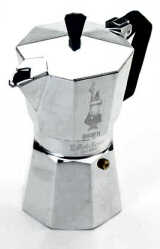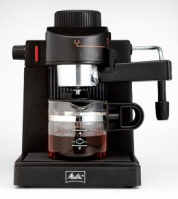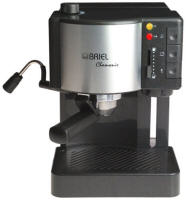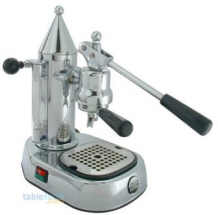There really is no single right way to build an espresso machine. For that reason, you’ll see hundreds of varieties, from the candle-driven models found in antique stores to the impressively proportioned, dual thermostat-controlled, multi-chambered machines in cafes. However, all machines can be categorized as either steam or pump driven. I’ve gone to all the trouble of explaining how both types work, and I’ve even scrounged up a few examples for you — so learn something, dammit!
Steam will rise
Steam machines simply work by pressure. Water heats up in an airtight chamber, becomes steam, and is quickly forced through coffee grounds and into a carafe or cup.

Stovetop models are the simplest type of espresso machines. In fact, I hesitate to call them “machines,” as there aren’t necessarily any moving parts. In these machines, a water reservoir rests on the stove. The coffee sits on top of that, enclosed by a screen on the top and bottom. When the water boils, the steam goes up through the lower screen, into the coffee, and out the upper screen. From there it travels up a small pipe and into the top chamber, where it trickles down and is kept warm.

Pumpless electric machines work pretty much the same way as the stovetop models, only an electric coil heats the water. Such machines have a steam wand so you can froth milk and make a latte or cappuccino or whatever. These inexpensive appliances are often sold in department stores, especially between, oh, late November until late December, for some reason.
Pump up the volume
Pump machines don’t allow the water to boil and become steam. Instead, the water is pumped through the coffee at a slightly cooler temperature. When done correctly, pump machines produce a better shot of espresso than their steam driven counterparts.

Electronic pump machines are what you’ll find in almost every cafe these days, and more home versions are coming out every year. With these machines, you calibrate the exact temperature you want the water to get to before the machine quickly pumps it through the coffee grounds. The power of the pump is typically measured in bars — for you scientifically minded folks, one bar is 10e5 Pascals. The lower end of these machines may be temperature-calibrated at the factory to take away the art and mystique of setting the temperature yourself.

Manual lever machines don’t have an electric pump and they don’t rely on steam pressure. Instead, water is heated to the proper temperature and it’s up to the barista (read: you) to squeeze the water through the coffee by means of a large, often metal handle. Some espresso fanatics insist on these. They’re also a great way to prove your manhood, impress the ladies, etc. You’ll occasionally find a cafe that uses these types of machines, but it takes more skill to operate these than college freshmen working for minimum wage are likely to care to possess. Oh, if you haven’t already guessed: the phrase “pulling a shot” refers to these machines, since you actually have to, well, pull a shot.
“Super automatic” pump machines do everything for you — grind, tamp, and pump. All you have to do is feed one of these beans and water, and clean it every now and then (though some even do this last step for you.) Every year manufacturers add more features to these things. Some of them even steam the milk, filter your water, and allow you to program every aspect of the espresso-making process. It’s only a matter of time before someone creates a super automatic machine that — I’m not joking — roasts coffee for you.
Before I forget…
The first few times you use any machine, you’re going to get a lousy shot. It’s just part of life, so get used to it. But fear not! I’ve typed up a handy guide on how to pull a shot like a pro, which includes a cheat sheet and some guidelines on getting the best shot from the aforementioned types of machines. If you’ve never made espresso before at all, you might want to read how to get started and you’ll be off to a good start (assuming you follow the directions.)

